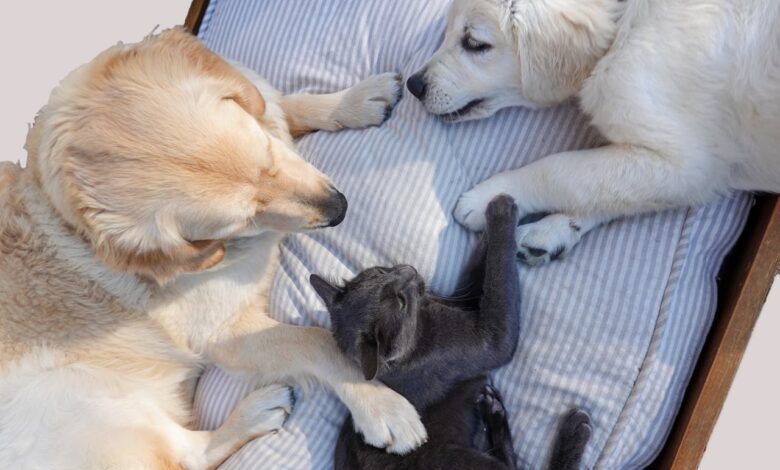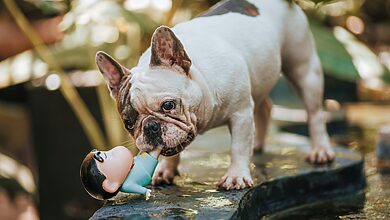Happy Together: A Guide to Successful Cat and Dog Integration

Cat and dog integration into the same household can be a rewarding experience, but it also requires careful planning, patience, and understanding. This guide will provide you with essential strategies and insights to ensure a smooth transition and foster a harmonious relationship between your feline and canine companions. We’ll cover key topics such as the importance of gradual introductions, creating separate spaces, managing pet jealousy, positive reinforcement training, and much more.
Bringing a new pet into a home already shared by another animal can be an exciting yet daunting experience. The prospect of introducing a cat and dog to each other often sparks a mix of anticipation and apprehension. Rest assured, with careful planning and patience, it’s entirely possible to create a harmonious multi-pet household.
In this guide, we’ll explore the common challenges faced when integrating cats and dogs, providing practical tips and expert advice to help you navigate this journey successfully. From initial introductions to long-term coexistence, we’ll share strategies to foster a positive and loving environment for both pets.
The Importance of Gradual Introductions
When bringing a new pet into a home that already has an established furry family member, gradual introductions are crucial. Cats and dogs have different communication styles, and a sudden introduction can lead to stress and conflict.
Why Gradual Introductions Matter
Gradual introductions help both pets adjust to each other’s presence without feeling threatened. This process allows them to familiarize themselves with each other’s scent, sounds, and behavior patterns in a controlled manner. Rushing this process can result in negative experiences that may take much longer to resolve.
Steps for a Successful Introduction
- Scent Swapping: Begin by exchanging bedding or toys between the pets. This helps them get used to each other’s scent in a non-threatening way.
- ASPCA on Introducing Pets
- Separate Spaces: Keep the pets in separate areas of the house initially, allowing them to hear and smell each other without direct contact.
- Humane Society: How to Introduce Dogs to Cats
- Controlled Meetings: Once they seem comfortable with the scent, start with controlled face-to-face meetings. Use barriers like baby gates to prevent direct contact while allowing visual and olfactory interaction.
- PetMD on Introducing Dogs to Cats
- Short Sessions: Keep initial meetings short and gradually increase the duration as they become more comfortable.
- International Cat Care
Creating Separate Spaces for Cats and Dogs
Ensuring that each pet has its own space is vital for a peaceful coexistence. Cats and dogs have different territorial needs, and providing separate areas can prevent territorial disputes.
Designing Separate Spaces
- Safe Zones for Cats: Cats need vertical spaces to feel secure. Provide cat trees, shelves, or perches where they can observe without feeling threatened.
- Jackson Galaxy: Catification
- Private Areas for Dogs: Dogs benefit from having a designated space where they can retreat. A crate or a cozy corner with their bed can serve this purpose.
- Separate Feeding Areas: To avoid competition and stress, feed cats and dogs in different areas. This also helps prevent food guarding behaviors.
- Pets Best: Feeding Multiple Pets
- Litter Box Placement: Ensure the litter box is placed in a quiet, accessible location where the dog cannot disturb the cat.
- The Spruce Pets on Litter Box Location
Managing Pet Jealousy and Competition
Jealousy and competition can arise when pets feel that they are not receiving equal attention or resources. Managing these feelings is essential to maintaining harmony in a multi-pet household.
Tips to Prevent Jealousy
- Equal Attention: Spend quality time with each pet separately to ensure they feel valued and loved.
- PetMD on Pet Jealousy
- Consistent Routines: Maintain consistent feeding, play, and exercise routines for both pets.
- Paws.org on Multi-Pet Homes
- Positive Reinforcement: Reward both pets for positive interactions and behaviors to encourage a friendly relationship.
- ASPCA on Positive Reinforcement
- Avoid Favoritism: Be mindful not to show favoritism, as this can exacerbate feelings of jealousy.
- The Humane Society on Multi-Pet Homes
Positive Reinforcement Training for Both Pets
Training is a critical component of integrating cats and dogs successfully. Positive reinforcement techniques can help shape desirable behaviors and improve communication between you and your pets.
Training Techniques
- Basic Commands for Dogs: Teach dogs basic commands like sit, stay, and leave it. This helps in managing their behavior during interactions with the cat.
- American Kennel Club on Basic Commands
- Desensitization for Cats: Gradually expose cats to the presence of the dog in a controlled manner, rewarding calm behavior with treats or affection.
- Rewarding Calm Behavior: Use treats, praise, and petting to reward both pets for calm and friendly interactions.
- Petfinder on Positive Reinforcement
- Interactive Play: Engage both pets in interactive play to build positive associations with each other’s presence.
Safety First: Preventing Accidents
Safety should always be a priority when introducing cats and dogs. Taking precautions can prevent accidents and ensure that both pets feel secure.
Safety Measures
- Supervised Interactions: Always supervise interactions between pets until you are confident in their behavior.
- PetMD on Supervised Interactions
- Escape Routes for Cats: Ensure cats have escape routes and high places to retreat to if they feel threatened.
- Jackson Galaxy on Safe Spaces
- Secure Outdoor Areas: If pets share outdoor space, make sure it is secure and that there are no escape routes.
- American Humane on Outdoor Safety
- Monitoring Body Language: Pay attention to both pets’ body language to intervene if necessary and prevent potential conflicts.
Seeking Professional Help When Needed
Sometimes, despite your best efforts, integrating cats and dogs can be challenging. In such cases, seeking professional help from a veterinarian or a pet behaviorist can be beneficial.
When to Seek Help
- Persistent Aggression: If either pet shows persistent aggression despite gradual introductions, professional intervention may be necessary.
- Extreme Fear or Anxiety: If one of the pets exhibits extreme fear or anxiety, a professional can provide strategies to help them cope.
- Behavioral Issues: Any significant behavioral changes or issues should be addressed with the help of a professional to ensure the well-being of both pets.
- Pet Behaviorists and Trainers: How to Find One
The Role of Body Language in Cat-Dog Interactions
Understanding the body language of both cats and dogs is essential for facilitating positive interactions and preventing conflicts.
Key Body Language Signals
- Dogs: Wagging tail, relaxed ears, and a loose body indicate a friendly and relaxed dog. Conversely, stiff body, raised hackles, and growling suggest stress or aggression.
- ASPCA on Dog Body Language
- Cats: A relaxed cat will have a loose body, slowly blinking eyes, and a softly waving tail. Signs of stress or aggression include flattened ears, a puffed-up tail, and hissing.
- International Cat Care on Cat Body Language
- Recognizing Discomfort: Learn to recognize signs of discomfort or stress in both pets to intervene before a situation escalates.
Patience is Key: Overcoming Challenges
Integrating cats and dogs requires patience and persistence. There may be setbacks along the way, but staying patient and consistent can lead to a successful integration.
Tips for Maintaining Patience
- Set Realistic Expectations: Understand that integration is a gradual process that may take weeks or even months.
- Petfinder on Introducing Cats and Dogs
- Stay Calm: Pets can pick up on your emotions. Staying calm and composed helps them feel secure.
- PetMD on Staying Calm
- Celebrate Small Wins: Acknowledge and celebrate small milestones in the integration process to stay motivated.
- American Kennel Club on Celebrating Pet Milestones
Creating a Mutually Respectful Environment
Fostering mutual respect between your cat and dog is crucial for a peaceful coexistence. This involves teaching both pets to respect each other’s space and boundaries.
Strategies for Mutual Respect
- Training Boundaries: Train dogs to respect the cat’s space, especially around food and resting areas.
- American Society for the Prevention of Cruelty to Animals
- Respecting Retreats: Teach the cat that the dog’s resting area is off-limits to prevent unnecessary conflicts.
- PetMD on Respecting Boundaries
- Positive Interactions: Encourage and reward positive interactions to build a foundation of mutual respect.
- Petfinder on Encouraging Positive Interactions
Success Stories: Inspiring Examples of Cat and Dog Bonds
Hearing success stories can provide hope and inspiration as you work on integrating your pets. Many cats and dogs have formed strong, loving bonds despite initial challenges.
Real-Life Examples
- Luna and Max: Luna, a timid cat, and Max, an energetic puppy, initially struggled to get along. Through gradual introductions and positive reinforcement, they became inseparable companions who love to play and cuddle together.
- Petfinder: Luna and Max’s Success Story
- Bella and Oscar: Bella, a senior cat, was wary of Oscar, a young rescue dog. With patience and separate spaces, they gradually developed a mutual respect and now enjoy lounging in the same room peacefully.
- Humane Society: Bella and Oscar’s Journey
- Milo and Daisy: Milo, a playful kitten, and Daisy, a gentle older dog, quickly bonded over their love for interactive toys. Their playful interactions and shared love of treats solidified their friendship.
- ASPCA: Milo and Daisy’s Friendship
Cat and Dog Integration
Integrating a cat and dog into the same household can be a rewarding experience for both pets and their human companions. While challenges may arise, with patience, consistency, and understanding, it’s possible to create a thriving multi-pet family.
Remember, every pet is unique, and the integration process may vary. Celebrate small victories, and don’t hesitate to seek professional guidance if needed. By following these tips and creating a safe, nurturing environment, you can foster a harmonious bond between your feline and canine friends.
Integrating cats and dogs requires careful planning, patience, and understanding. By following the strategies outlined in this guide, you can create a harmonious environment where your pets can thrive together. Remember, every pet is unique, and their integration journey will be different. Stay patient, seek professional help if needed, and celebrate the small victories along the way. Happy integrating!
FAQ: About Cat and Dog Integration
1. How long does it typically take for a cat and dog to get along?
The time it takes for a cat and dog to become comfortable with each other varies greatly depending on the individual personalities of the pets involved. It can take anywhere from a few days to several months. Patience and consistency are key.
2. How do I introduce my cat and dog for the first time?
Gradual introductions are essential. Start by allowing the pets to smell each other through closed doors. Once they seem calm, supervised interactions can begin. Always ensure a safe space for the cat to retreat if needed.
3. What if my cat hisses or growls at the dog?
Hissing and growling are normal feline reactions to new situations. Avoid punishing the cat for these behaviors. Continue with gradual introductions and provide plenty of hiding spots for the cat.
4. What if my dog is too excited or playful around the cat?
Excessive enthusiasm from the dog can be overwhelming for the cat. Use commands like “leave it” and “sit” to calm your dog down. Create separate playtimes for each pet to prevent territorial disputes.
5. How can I prevent resource guarding?
Resource guarding occurs when a pet protects food, toys, or sleeping areas. Provide separate feeding and resting areas for both pets. Avoid interfering during mealtimes or when one pet is in their designated space.
6. What if my cat or dog shows signs of stress?
Signs of stress include hiding, increased vocalization, changes in appetite, or aggression. Consult with a veterinarian or animal behaviorist to develop a tailored plan to address the stress.
7. Can I use pheromone diffusers to help with the integration process?
Pheromone diffusers can help create a calming environment for both pets. They can be particularly beneficial during the initial introduction phase and for managing anxiety.
8. Is it necessary to crate my dog during the integration process?
Crating your dog can provide a safe space for them during the initial stages of integration. It can also help prevent accidents and reduce territorial disputes.
9. How can I encourage positive interactions between my cat and dog?
Reward positive interactions with treats and praise. Create opportunities for supervised play sessions in a neutral area. Gradually increase the duration of these interactions as the pets become more comfortable with each other.
10. What if the integration process isn’t working?
If you’re struggling with the integration process, seeking professional help from a veterinarian or animal behaviorist is recommended. They can provide tailored advice and support.







